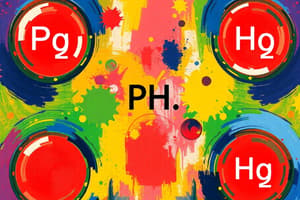Podcast
Questions and Answers
What defines an acid according to the Arrhenius theory?
What defines an acid according to the Arrhenius theory?
An acid is defined as a substance that dissociates in aqueous solution to give H+ ions.
How do strong acids differ from weak acids in terms of dissociation?
How do strong acids differ from weak acids in terms of dissociation?
Strong acids dissociate almost completely, while weak acids dissociate partially.
According to the Lowry-Bronsted theory, what roles do acids and bases play?
According to the Lowry-Bronsted theory, what roles do acids and bases play?
Acids are proton donors, while bases are proton acceptors.
Describe the formation of hydronium ions from an acid in solution.
Describe the formation of hydronium ions from an acid in solution.
What role do lone pairs of electrons play in the formation of H3O+?
What role do lone pairs of electrons play in the formation of H3O+?
Explain why the oxygen atom in water has a slight negative charge.
Explain why the oxygen atom in water has a slight negative charge.
How is the hydroxyl ion (OH-) formed from ammonia in aqueous solution?
How is the hydroxyl ion (OH-) formed from ammonia in aqueous solution?
What is the significance of the coordinate covalent bond in these ion formations?
What is the significance of the coordinate covalent bond in these ion formations?
Describe the charge distribution of a water molecule.
Describe the charge distribution of a water molecule.
What happens to the H+ ion during the formation of ammonium ion from ammonia?
What happens to the H+ ion during the formation of ammonium ion from ammonia?
Flashcards are hidden until you start studying
Study Notes
Arrhenius Theory
- Acids dissociate in aqueous solutions to release H+ ions.
- Strong acids dissociate almost entirely, while weak acids only partially dissociate.
Lowry-Bronsted Theory
- Defines acids as proton donors and bases as proton acceptors, recognizing protons as H+ ions.
Hydronium Ions (H3O+)
- Formed when acids dissolve in aqueous solutions.
- The water molecule is polar, with a slight positive charge on hydrogen and a slight negative charge on oxygen.
- Oxygen in water possesses two lone pairs of electrons that are not shared.
Formation of Hydronium Ion
- HCl (an acid) reacts with water:
- HCl + H2O → H3O+ + Cl-
- A proton (H+) released from the acid binds to oxygen's lone pair, forming a coordinate covalent bond.
Hydroxyl Ions (OH−)
- Formed from alkalis, like ammonia (NH3), in aqueous solution.
Ammonia Molecule
- Ammonia can react with water to form hydroxyl ions:
- NH3 + H2O → NH4OH → OH− + NH4+
- A proton from water adds to the nitrogen atom's lone pair, forming a coordinate covalent bond.
Ammonium Ion (NH4+)
- Formed during the reaction when NH3 accepts a proton.
- Ammonia is a polar covalent molecule due to significant electronegativity differences between nitrogen and hydrogen atoms.
Studying That Suits You
Use AI to generate personalized quizzes and flashcards to suit your learning preferences.




